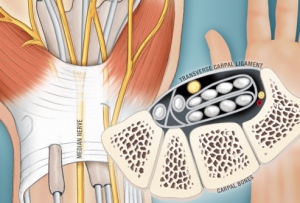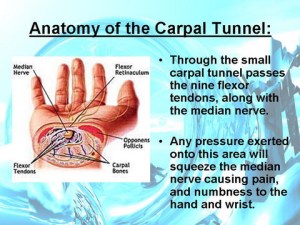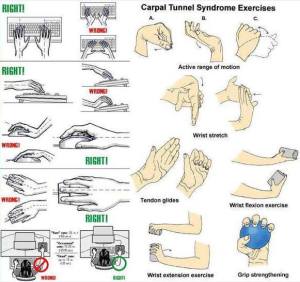 What is Carpal Tunnel Syndrome?
What is Carpal Tunnel Syndrome?
The American Society for Surgery of the Hand defines Carpal Tunnel Syndrome (CTS) as a “condition brought on by increased pressure of the median nerve at the wrist”. The median nerve runs from the forearm into the palm of the hand. When the median nerve becomes compressed, it causes inflammation in the eight carpal bones located in each wrist.
Those affected by Carpal Tunnel Syndrome describe the condition as a tingling, numbness, or painful sensation in the hands and fingers. Women are three times more likely to be afflicted with CTS than men because they have smaller carpal tunnel area in their wrists. According to the National & International Statistics on Carpal Tunnel Syndrome, the condition is the “most common nerve compression disorder of the upper extremity”. CTS affect more and more people each year. It is important to have knowledge on the proper treatments for the disorder as well as preventative methods.
 What causes Carpal Tunnel Syndrome?
What causes Carpal Tunnel Syndrome?
The direct cause(s) of Carpal Tunnel Syndrome are still unknown however they have been linked to a combination of factors leading to the condition. Carpal Tunnel Syndrome can be caused by the following reasons:
- Health Conditions– Diabetes, rheumatoid arthritis, and thyroid conditions have been associated with CTS. People with these health illnesses have an increased chance of damaging their median nerve.
- Injury– Sprains, fractures or joint dislocations of the forearm and/or wrists can increase the risks of nerve damage.
- Environment/Workplace– Repetitive flexing of the wrist(s) such as typing on a computer or using a power tool for a prolonged period of time can be harmful to the tendons and nerves in the arm, wrist and hand.
Symptoms of CTS
The symptoms of Carpal Tunnel Syndrome are included in the following:
- Tingling in the fingers or hand
- Numbness in the fingers or hand
- Pain in the palm of the hand
- Weakness in the arm and hand
Diagnosis of CTS
To properly diagnose Carpal Tunnel Syndrome, your doctor may want perform a physical exam of your fingers, hands, arms and shoulders because these area can be affected by the disorder. An x-ray may be required to test for underlying conditions such as arthritis that may cause CTS.
 Treatment of CTS
Treatment of CTS
Carpal Tunnel Syndrome can be treated with wearing a wrist splint during the daytime and nighttime. A splint holds your wrist still while you are performing tasks. Corticosteroid injections may relieve the pain associated with the condition. In severe cases, surgery may be needed to make more room for the median nerve.
Alternative Treatments to CTS
Alternative treatments to Carpal Tunnel Syndrome are methods to alleviate pain in the fingers, hands and/or wrists. Yoga, hand therapy and exercises, acupuncture, acupressure, hypnotherapy and proper nutrition can help reduce inflammation or swelling.
Preventing CTS
Carpal Tunnel Syndrome can be prevented by taking frequent breaks and stretching your hands and wrists. Other methods include improving posture, keeping your hands warm to prevent stiffness, and relaxing the grip while holding objects.
Resources
American Society for Surgery of the Hand
National Institute of Neurological Disorders and Stroke
 This article is written by Hang Pham, Monterey Bay Holistic Alliance Health and Wellness Educator. Hang Pham was born in Hoc Mon, Vietnam. She came to America in 1994, becoming a U.S. citizen in 2011. Hang graduated from Seaside High School with diploma and received her AA in General Studies from Monterey Peninsula College in 2011. She received her BA in Collaborative Health and Human Services from California State University Monterey Bay (CSUMB) in 2012. In addition to working as a volunteer staff with the Monterey Bay Holistic Alliance, she currently works as a Clerical Aid in the Human Resources Department of Salinas City Hall. To find out more about our Health Educators, or to apply as a Monterey Bay Holistic Alliance writer or volunteer, visit our website at www.montereybayholistic.com
This article is written by Hang Pham, Monterey Bay Holistic Alliance Health and Wellness Educator. Hang Pham was born in Hoc Mon, Vietnam. She came to America in 1994, becoming a U.S. citizen in 2011. Hang graduated from Seaside High School with diploma and received her AA in General Studies from Monterey Peninsula College in 2011. She received her BA in Collaborative Health and Human Services from California State University Monterey Bay (CSUMB) in 2012. In addition to working as a volunteer staff with the Monterey Bay Holistic Alliance, she currently works as a Clerical Aid in the Human Resources Department of Salinas City Hall. To find out more about our Health Educators, or to apply as a Monterey Bay Holistic Alliance writer or volunteer, visit our website at www.montereybayholistic.com
